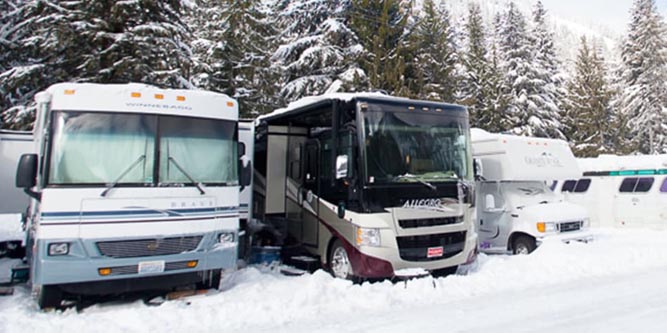When you’re traveling with an RV or camper, you have to handle a lot of your own sanitation needs. And the number one requirement for sanitation is water. In total, most RVs have three tanks: one each for fresh, grey, and black water. Fresh water is what it sounds like – fresh, potable water for your sink and faucet. Grey water is the runoff from your shower or sink. Black water, to put it bluntly, is what goes down when you flush the toilet. Whenever you stop off, you need to top off your fresh water, and empty your grey and black water. But how do you do this when you’re RVing in cold, winter weather?
The answer is to use an RV tank heater. An RV tank heater is exactly what it sounds like: a heater that keeps your RV tanks warm. In most cases, these pads adhere to the bottom of your tank, and are kept warm via an electrical current. You wire the pads into a switch, which can then be used to turn them on or off. Nowadays, most heaters have their own internal thermostat. This keeps them from running when the temperature is above freezing. When the temperature gets too low, they kick in, and your water tanks are all kept warm. In general, you’ll want to use three pads: one for each tank. You’ll also want to insulate any exposed piping. With these combined efforts, your water will remain liquid, and your pipes won’t burst.
We’re about to review three of today’s most popular RV holding tank heater pads. First up, we’ll examine the Facon RV Tank Heater Pad. This pad is available in two variants: one with a hardwired design, and another with a two-pronged AC plug. Next, we’ll look at the RecPro RV Tank Heater Pad. This hardwired pad is available in a multi-pack, for easily covering all three tanks. Last but not least, we’ll check out the UltraHeat RV Tank Heater. This is an exceptionally powerful heater that works down to -11 degrees Fahrenheit. But which one is the right choice for you? Let’s look a little closer at each of these heaters, and see how they stack up.

Do I Need an RV Tank Heater?
As you might imagine, there are some circumstances where an RV tank heater is a necessity. But not every RVer automatically needs to install an RV heater. For one thing, many people only go out RVing in the summertime, or during balmy spring and fall weather. In those cases, you don’t need a heater. Just make sure to drain your tanks and winterize before foul weather hits, and you’ll be okay. Along the same lines, you don’t need a heater if you travel south every winter. Since you’re avoiding cold weather to begin with, heating isn’t a concern.
One alternative to using an RV heater is to add antifreeze to your RV tanks. This is easy to do, and it’s a viable option for grey and black water tanks. That said, antifreeze is toxic, so you can’t add it to your fresh water tank. So you’ll still need a heater on that tank, or you won’t be able to have running water. You can also build an insulated skirt around the bottom of your RV. This is the most energy-efficient option, and it’s a great solution if you’re staying in the same place all winter. On the downside, it’s not very portable, so it’s a non-starter if you’re on the road a lot.
Thankfully, RV tank heaters are relatively inexpensive. By the time you’ve added antifreeze to your black water all winter, you could have paid for a new heater. They’re also not that difficult to install. If you’ve done any electrical work on your RV at all, you already possess the necessary skills.

What Kind of Heater Should I Buy?
So, you need an RV heater, and you’re not sure where to begin. What should you be looking for? To begin with, you should be looking for one that installs with adhesive. There’s just no easier way to do it, and modern adhesives are more than up to the job. There’s one big caveat to this, though; adhesive is also a pain to remove if something goes wrong. So make sure to test your heater by wiring it up before you stick it on. It takes just a minute to test, and you can potentially save yourself a lot of headache. Even so, adhesive installation is by far the ideal option, as well as being nearly universal.
The next thing you need to think about is how you use your RV or camper. If you spend most of your time on the road, you want to use a 13.5-volt DC heater. These will wire directly into your vehicle’s converter, and will run whenever your RV power is active. So whether you’re driving or idling, your water will stay warm.
Then again, you might spend most of your time at campgrounds with power connections. In that case, it doesn’t make sense to run on RV power, since your engine would need to be idling. Instead, look for a heater that will run on standard AC power. Then, you can use an extension cord to plug in your heaters whenever you pull up. As long as you’re not driving with water in your tanks, you’ll be covered for the length of your stay.
But what if you want to keep your tanks warm at all times? In those cases, you can simply install two sets of heaters. You can run your hardwired heaters on the road, and use AC-powered heaters when you’re parked. That way, you can get the benefits of both, without any of the limitations. You can also order hybrid heaters that can run on either type of power. That said, these are more expensive, and more complicated to install.
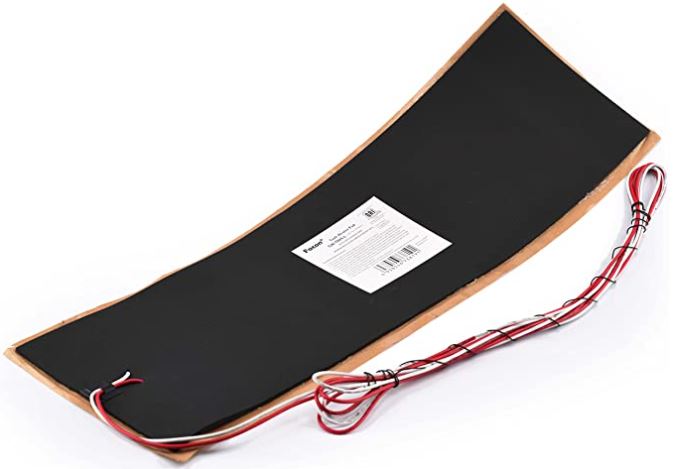
Facon RV Tank Heater Pad
The Facon RV Tank Heater Pad is a slim, black, rubbery pad with a rectangular shape. The one we reviewed had dimensions of 8 inches by 25 inches, but other sizes are readily available. Regardless of what size you use, installation works pretty much the same way. When you open the box, the pad will be backed with a brown waxed paper. This paper peels away easily, allowing for quick, painless installation.
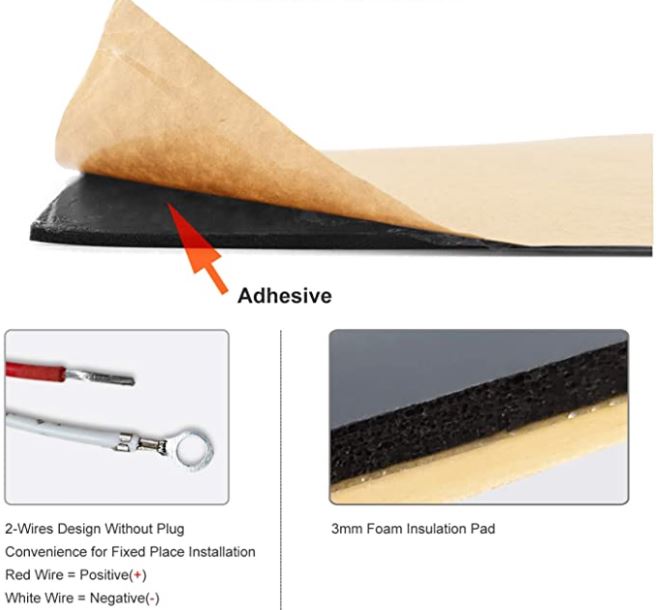
The unique thing about this heater pad is that it comes in two different variants. The first comes with a wiring harness, which is designed to be wired directly into your RV. The other has a simple, 72-inch two-prong AC power cord. So whether you need to plug in on the road or plug into the grid, you’ll be all ready to go.
The Facon heating pad has a built-in thermostat that automatically turns it on and off as needed. When the ambient temperature drops to 45 degrees, it will kick in. When the temperature rises to 68 degrees, it will turn off. This ensures that your water won’t freeze, without wasting energy when it’s warm out. The system works well on tanks up to 50 gallons in volume. Beyond that, and you might start running into trouble. Then again, you can always add more pads to a larger tank.
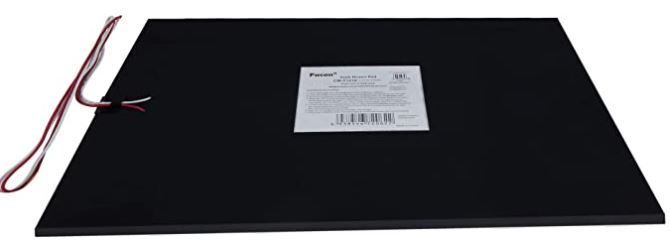
RecPro RV Tank Heater Pad
Like the Facon heating pad, the RecPro RV Tank Heater Pad is available in multiple sizes. That said, the one we reviewed measures 12 x 18 inches, and we were pleased with the performance. It has a peel away backing, and can be attached to your water tanks in just a few minutes. That said, the only wiring option available is a hardwiring harness. If you want to plug into utility power, you won’t be able to.
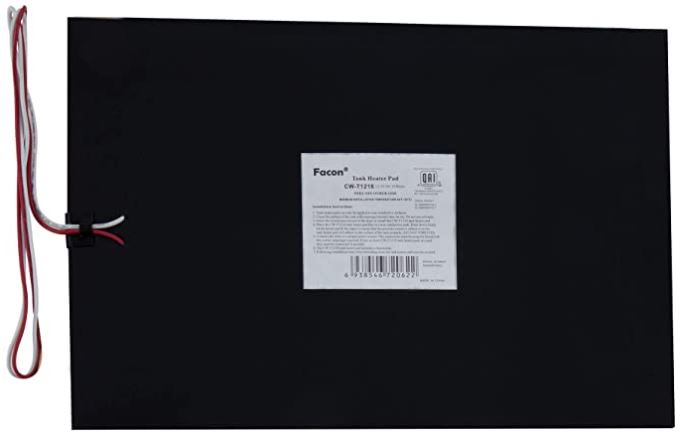
Then again, the heater performs admirably on the open road. It activates when the temperature drops below 45 degrees, and reactivates when it gets up to 68. It’s capable of heating up to a 50-gallon tank, so it performs just as well as the Facon. That said, RecPro offers multi-packs at a significant discount per heater. If you need to install multiple pads, you’ll get a great deal.

UltraHeat RV Tank Heater
The UltraHeat RV Tank Heater is another peel and stick, hardwired heater. We reviewed the 12 x 20-inch version, although there are many different sizes available. So far so good, but nothing to make it stand out from either of the first two heating pads.
What makes the UltraHeat heater special is the amount of heating capacity. It can keep up to a 55-gallon tank from freezing, even in the coldest weather. As a matter of fact, it keeps on working all the way down to eleven degrees below zero. To be fair, this heater isn’t cheap – it’s more than twice as much as the others. But you get what you pay for, and you’re getting an absurd amount of warming power.
Final Verdict
So, which one of these RV holding tank heater pads is the best? Let’s go over what we’ve learned. To begin with, the Facon RV Tank Heater Pad is a solid performer. It works with up to a 50 gallon tank, and it installs easily. Not only that, but you have the option to order it for an AC outlet. This makes it optimal if you spend a lot of time parked on the grid.
The RecPro RV Tank Heater Pad offers similar performance. It kicks in at 45 degrees, and shuts off at 68 degrees. It even heats the same size tank, with a volume of up to 50 gallons. On the downside, you can’t use it on the grid. But if you need all three heaters, you can get a great discount on the multi-pack.
The UltraHeat RV Tank Heater is the most powerful of the bunch. It will keep up to a 55 gallon tank from freezing, down to as low as -11 Fahrenheit. You’ll pay a lot more for this much power. But if you spend a lot of time in very cold weather, you’ll appreciate the high-powered performance.
Meet Ry, “TechGuru,” a 36-year-old technology enthusiast with a deep passion for tech innovations. With extensive experience, he specializes in gaming hardware and software, and has expertise in gadgets, custom PCs, and audio.
Besides writing about tech and reviewing new products, he enjoys traveling, hiking, and photography. Committed to keeping up with the latest industry trends, he aims to guide readers in making informed tech decisions.

